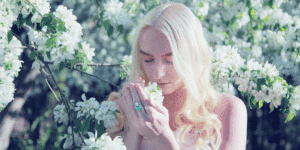How Eye Color Is Determined
Eye color is shaped by genetics, specifically the amount and type of melanin in the iris. Melanin is a pigment that also influences skin and hair color. Brown eyes contain higher levels of melanin, while blue and green eyes have less. According to Color Meanings, the variation in melanin levels creates the wide spectrum of eye colors seen across populations.
The iris, which is the colored part of the eye, has two layers. The amount of pigment in the front layer determines how light is absorbed and reflected, which gives the eye its visible color. For example, when melanin is sparse, light scatters in a way that makes the iris appear blue. When melanin is abundant, the iris appears brown or nearly black.
Although genetics play the largest role, eye color can also shift slightly over time. Some babies are born with lighter eyes that darken as melanin develops during early childhood. In rare cases, medical conditions can also affect pigmentation, though these changes are usually gradual.
Brown Eyes and Their Symbolism
Brown eyes are the most common worldwide, representing warmth and reliability in many cultural traditions. Brainwise Mind notes that people with brown eyes are often associated with nurturing qualities and emotional strength. This symbolism may stem from the prevalence of brown eyes, which makes them a familiar and grounding feature across communities.
In folklore, brown eyes have been linked to stability and trustworthiness. Communities often viewed individuals with darker eyes as dependable and protective. These associations continue today, where brown eyes are often described as comforting and approachable.
From a biological perspective, the higher melanin content in brown eyes also provides greater protection against ultraviolet light. This practical advantage may have contributed to the positive cultural associations with resilience and strength.
Blue Eyes and Their Meanings
Blue eyes are less common globally and often carry symbolic meanings tied to calmness and clarity. According to Spiritual Divine Insight, blue eyes are associated with intuition and inner peace. This symbolism may be influenced by natural imagery, as blue eyes are often compared to the sky or water.
Historically, blue eyes have been linked to mystery and uniqueness, particularly in regions where they are rare. In some traditions, they were thought to reflect heightened sensitivity or spiritual awareness. These associations continue in modern culture, where blue eyes are often described as reflective or contemplative.
The lighter pigmentation of blue eyes also makes them more sensitive to light. This biological trait may have influenced cultural interpretations, connecting blue eyes with heightened perception or awareness of the environment.
Green Eyes and Their Associations
Green eyes are among the rarest, often symbolizing renewal and balance. Brainwise Mind explains that green eyes are linked to resilience and healing energy. Their rarity has contributed to a sense of intrigue and fascination across cultures.
In folklore, green eyes were sometimes associated with creativity and adaptability. They were seen as a sign of someone who could thrive in changing circumstances. This symbolism aligns with the perception of green as a color of growth and renewal in nature.
Modern interpretations often emphasize the uniqueness of green eyes. Because they are uncommon, they are frequently highlighted in literature and media as distinctive and memorable. This cultural framing reinforces the idea that green eyes carry a special significance.
Hazel Eyes and Their Symbolism
Hazel eyes, which combine shades of brown and green, are often described as adaptable and versatile. Spiritual Divine Insight notes that hazel eyes symbolize emotional variety and transformation. Their shifting appearance in different lighting conditions may have contributed to this association.
Culturally, hazel eyes are often linked to curiosity and openness. They are seen as reflecting a balance between the stability of brown and the renewal of green. This duality makes hazel eyes a symbol of flexibility and balance.
The mixed pigmentation of hazel eyes also reflects genetic diversity. This biological trait may have influenced cultural interpretations, framing hazel eyes as a sign of adaptability and resilience.
Dark Eyes and Their Cultural Role
Very dark brown or black eyes are common in many parts of the world and often symbolize strength and protection. Spiritual Divine Insight describes black eyes as representing power and resilience. These associations may stem from the depth and intensity of the color, which can appear striking and commanding.
In cultural traditions, dark eyes have often been linked to guardianship and authority. Communities sometimes viewed individuals with very dark eyes as protectors, capable of guiding others through challenges. This symbolism continues in modern contexts, where dark eyes are often described as steady and grounding.
From a biological perspective, the high melanin content in very dark eyes provides strong protection against sunlight. This practical advantage may have reinforced cultural associations with strength and endurance.
Understanding Symbolism Across Cultures
The symbolism of eye colors varies across cultures, but common themes emerge. Brown eyes are linked to warmth and stability, blue eyes to calmness and intuition, green eyes to renewal, hazel eyes to adaptability, and dark eyes to strength. These associations reflect both cultural traditions and biological traits.
While symbolism can provide insight into how communities interpret physical traits, it is important to remember that eye color does not determine personality or destiny. Instead, these meanings reflect cultural values and shared experiences.
By exploring the symbolism of eye colors, people can gain a deeper appreciation for diversity. Each eye color carries its own history and associations, contributing to the richness of human identity.








